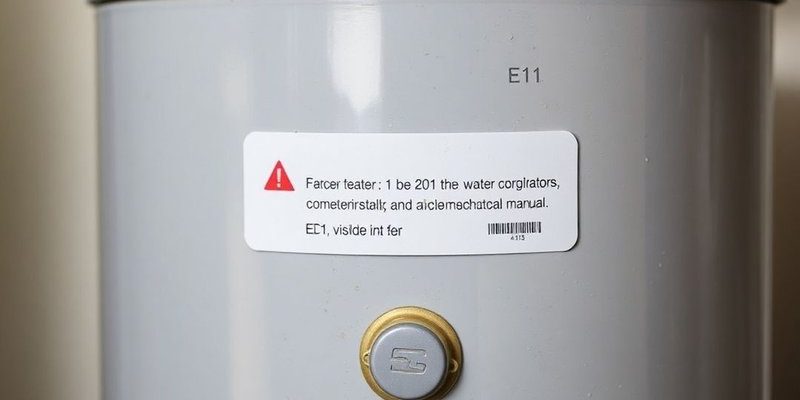
Think of error codes as your water heater’s way of speaking to you, letting you know when something’s not quite right. Just like how a car’s check engine light might flicker on when it needs a tune-up, the E1 code is your heater’s little cry for help. So, take a deep breath, and let’s dive into what this code is all about and how you can tackle it without breaking a sweat.
Understanding Error Code E1: The Basics
When your Kenmore water heater flashes an E1 error code, it usually signals a problem with the ignition process. Picture this: your water heater tries its best to spark up and warm the water, but something’s blocking its flow, much like an unlit campfire that refuses to ignite. This could be due to a lack of gas flow or an issue in the ignition system itself, much like a blocked fuel line in a car.
This error could arise from several factors. It might stem from a gas supply issue where the heater isn’t getting enough gas to light up and heat the water. Alternatively, there could be an issue with the ignition component that’s supposed to create a spark. Imagine trying to light a match in a windy room — frustrating, right? That’s essentially what your water heater is experiencing if its ignition system is faulty.
Understanding the E1 error code means identifying these problems. But don’t worry, it doesn’t require a mechanical engineering degree. The first step is ensuring your gas supply is steady and active. If the gas is flowing correctly, consider looking into the ignition system, which might need a bit of maintenance or replacement.
Common Causes of the E1 Error Code
So, what tends to cause this pesky E1 error code? Well, let’s break it down. First up, there’s the *gas valve* issue. If your gas valve is faulty or turned off, it might stop the heater from receiving the necessary gas to ignite, akin to trying to start a car without any fuel in the tank.
Then, there’s the *ignition system malfunction*. Sometimes, the ignitor, which is responsible for creating the spark to ignite the gas, can wear out over time. Imagine an old lighter that struggles to produce a flame — it might just need a replacement. This component failure can prevent your water heater from starting up properly.
Another potential cause could be a *clogged burner orifice*. This scenario is similar to a clogged faucet that prevents water from flowing smoothly. Over time, debris can build up and block the flow of gas to the burner, leading to inadequate ignition.
If you’re facing the E1 error, checking these potential culprits should be your first step. It’s a bit like detective work, but once you identify the cause, you can take the next steps to fix it.
Steps to Fix E1 Error Code
Now that we know what might be causing the E1 error, let’s tackle how to fix it. First and foremost, ensure your gas supply is on and uninterrupted. Check the gas valve — is it open and functioning correctly? If not, you might need to call in a professional to help.
Next, examine the ignitor. If it’s seen better days, consider replacing it — much like changing the battery in a remote control that’s stopped working. This simple swap can often solve the problem.
If the issue persists, check the burner orifice for any blockages. You might need some cleaning tools to clear out anything that’s causing a blockage. It’s like unclogging a drain to ensure everything runs smoothly again.
Remember, safety should be your priority. If the problem seems beyond your comfort level, don’t hesitate to contact a professional technician. They’re like the superheroes of household appliances and can ensure everything is running safely and smoothly.
Preventative Measures and Final Thoughts
Preventing the E1 error code is a bit like preventing a flat tire — routine maintenance can go a long way. Regularly check your water heater’s gas connections and keep the area around your heater clean and free from debris. This will help prevent blockages and ensure a steady gas flow.
You might also consider scheduling regular check-ups with a professional technician, much like taking your car in for service. They can spot potential issues before they become full-blown problems, saving you from unexpected cold showers.
In conclusion, while the E1 error code can be a nuisance, it’s not the end of the world. With a little patience and the right steps, you can either fix the problem yourself or know when to call in some expert help. Here’s to always having a warm, relaxing shower without any interruptions!
